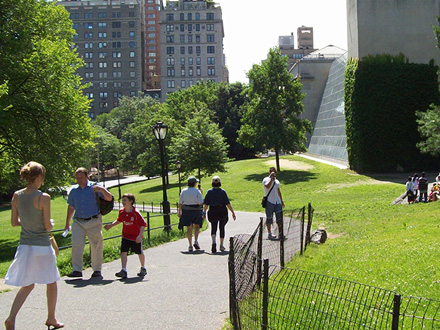By Megan Avakian

Living near green spaces may protect against the harmful effects of air pollution on vascular health, according to a new study funded by NIEHS .
Previous research supports a link between neighborhood greenness and a lower cardiovascular disease risk. Green areas encourage outdoor exercise, promote social interaction and community cohesiveness, and reduce stress. Trees also capture and filter air pollutants - which are known to impair heart health - from the environment.
"Most of the evidence linking green space and health is associative; we don't really understand why greenness is beneficial. By examining the relationship between vascular health, green space, and air pollution, our study provides better insight into the mechanisms by which greenness affects health," said lead study author, Aruni Bhatnagar, Ph.D., from the University of Louisville.
To investigate this link, the researchers used pulse wave analysis to measure arterial stiffness in 73 study participants with conditions such as diabetes, obesity, high blood pressure, and high cholesterol, that put them at moderate-to-high risk of cardiovascular disease. Measures of arterial stiffness included: augmentation index, augmentation pressure, pulse pressure, aortic systolic pressure, and the sub-endocardial vitality ratio (SEVR).
"We measured arterial stiffness - which reflects hardening of arteries - because we know from clinical studies that it is a strong predictor of future cardiovascular events. So, it is a very good surrogate for cardiovascular disease risk," said Bhatnagar.
On average, study participants were 52.2 years old. Of the 73 participants, 51% were female, 53% were Black, and 79% had been diagnosed with hypertension.
In their analyses, the researchers accounted for factors that have been linked to increased cardiovascular disease risk, such as socioeconomic status, physical activity, and tobacco use. They used block group level data from the 2010 U.S. Census to assess participant median household income - a proxy for socioeconomic status.
Using satellite data from the U.S. Geological Survey, the researchers estimated the normalized difference vegetation index within 200 meters and 1 kilometer of participants' homes. These distances represented the space around and within walking distance of participant residences, respectively. The research team used data from local air pollution monitoring stations to estimate exposure to particulate matter (PM2.5, PM10) and ozone for the week before and including the day study participants had their arterial stiffness assessed. They calculated moving averages based on short-term exposure windows of 1, 3, and 7 days.
Green Heart Study
Bhatnagar also leads the Green Heart Study , an ambitious and first of its kind project to assess whether increasing residential vegetation decreases cardiovascular disease risk. After planting thousands of trees in Louisville, Kentucky, neighborhoods, the researchers will monitor changes in air pollution, physical and mental health, and social ties over a two-year period. They will also compare the results to residents from neighborhoods that did not receive the greening intervention.
The study is funded through a partnership between NIEHS, the Nature Conservancy, and the Hyphae Design Labs. NIEHS is funding assessment of the impact of green space on air quality and health in urban communities. The Nature Conservancy is supporting the planting of large mature trees using patterns of urban design developed by Hyphae Labs to lessen local air pollution.
Greener Neighborhoods, Healthier Hearts
Living in areas with more green space was strongly correlated with lower arterial stiffness at both the 200 m and 1 km distances. This study is one of the first to demonstrate this inverse relationship, which remained significant even after adjusting for household income, physical activity, and tobacco use.
Arterial stiffness was strongly associated with short-term exposure to ambient air pollutants. Higher 1-day PM2.5 levels were associated with increased augmentation pressure, pulse pressure, and aortic systolic pressure. Higher 1-day ozone levels were positively associated with augmentation index, augmentation pressure, and aortic systolic pressure. The associations with PM2.5 and ozone were lost when the researchers used 3- and 7-day pollution levels.
The link between air pollution and poor vascular health was stronger in low green space areas. However, among people living in areas of high vegetation, there were no significant associations between vascular health and air pollution. In areas of low greenness, both higher ozone and PM2.5 were associated with increased pulse pressure. In addition, there was a positive association between ozone and augmentation pressure and systolic blood pressure in low green space areas. However, in areas of high vegetation, the relationship between measures of arterial stiffness with either PM2.5 or ozone was not significant.
"Our results suggest that residential greenness is associated with better vascular function, in part by attenuating the effects of ambient air pollution," said Bhatnagar. "People in greener areas appeared to be more resilient to air pollution exposures than people living in less green areas."
A Global Vision for Greener, Healthier Cities
More than half of the world's population lives in urban areas. This number is expected to increase to over two-thirds by 2050, with most of the rural-to-urban shift occurring in Asia and Africa, according to the United Nations (UN) .
Although urban living comes with increased access to health promoting resources, like health care and improved water and sanitation infrastructure, it also limits access to nature and increases exposure to air pollution and other environmental hazards. According to the World Health Organization, more than 80% of people living in urban areas are exposed to harmful levels of air pollution with populations in low- and middle-income cities being the most impacted.
Studies like Bhatnagar's can provide the scientific evidence needed to inform urban design and guide public policies that recognize the value of greening our cities. The UN's Sustainable Development Goals highlight this need, calling for cities with increased access to green space for all citizens.

